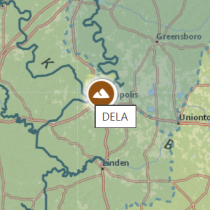NEON Receives Construction Funding from National Science Foundation, Slated to Begin Building Fall 2011
July 28, 2011
Scientists and decision makers will soon have access to information critical for understanding the effects of environmental change on a massive scale through NEON, the nation’s first continental-scale ecological observatory. The National Science Foundation (NSF) will fund the $434 million construction of the observatory, starting with $18 million in FY 2011.
NEON plans to build 62 sites across the U.S., utilizing cutting-edge technology that will gather and synthesize continental-scale data over 30 years on the impacts of climate change, land use change and invasive species on natural resources and biodiversity. Such information will support the ability to understand and predict environmental change on regional and continental scales. “The hard work and dedication of the NEON team over the past three years has been the key to bringing the observatory to life,” said Tony Beasley, NEON’s Chief Operations Officer. “This is an outstanding outcome for this team and the field of ecology, and I am proud to be part of this effort.”
Recent assessments indicate that U.S. ecosystems will experience abrupt and unpredictable changes due to human causes in the near future. The Obama Administration has identified these issues as among the most important, demanding, and urgent global problems of our time. According to the NSF, scientific discovery and science-based decision making are critical to selecting mitigation and adaptation policies and strategies so that we can preserve our national resources, economic vitality, health, quality of life, and national security supports. NEON is the platform to provide the scientific foundation needed to address these environmental challenges. With a construction start in FY 2011, NEON will provide an unprecedented opportunity to detect signals for environmental change as early as FY 2012. “It’s absolutely critical to begin and complete the NEON project as soon as possible. Our living world is changing rapidly, and NEON’s early observations will provide the continental baseline we need to understand and forecast the likely environmental changes we could see over the coming decades,” said NEON Chief Science Officer Dave Schimel.
As a continental research instrument, NEON will support a large and diverse group of organizations and individuals. All NEON data and information products will be made available in near real-time to scientists, educators, students, decision makers, and the public. Given the current economic climate, NEON is honored and grateful to be given the chance to move forward with its work. NEON’s construction funding will be provided through NSF’s Major Research Equipment and Facilities (MREFC) budget account. In order for a project to be considered for MREFC funding, NSF requires that it represent an exceptional opportunity that enables research and education. In addition, the project should be transformative in nature in that it should have the potential to shift the paradigm in scientific understanding. NEON meets these criteria based on NSF and National Science Board review.
NEON anticipates beginning to construct the first of its sites in Colorado and New England over the next 12 months. NEON staff are working closely with site owners, permitting agencies and local governments to ensure the sites are examples of good science and stewardship in the community. NEON plans to begin full operations at some of the completed sites in late 2012. Funding for construction culminates over ten years of visioning, planning and reviewing of the NEON concept. “This is truly a triumph for the hundreds, really the thousands of people who have given so much of themselves to make NEON a reality,” said Jim MacMahon, Chair of NEON’s Board of Directors. “We’re ready to bring the next generation of environmental observation to those working to understand, predict and respond to environmental change on a grand scale.”
